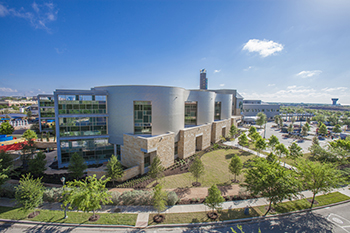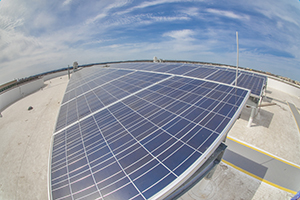Dell Children’s Becomes First to Achieve LEED-HC Platinum
 AUSTIN, Texas — The new LEED-HC rating continues to make its mark as the new W.H. and Elaine McCarty South Tower at Dell Children’s Medical Center of Central Texas in Austin became the first-ever to achieve the LEED-HC Platinum designation. This is the hospital’s second record-breaking LEED designation after it became the world’s first LEED Platinum-certified hospital in 2008.
AUSTIN, Texas — The new LEED-HC rating continues to make its mark as the new W.H. and Elaine McCarty South Tower at Dell Children’s Medical Center of Central Texas in Austin became the first-ever to achieve the LEED-HC Platinum designation. This is the hospital’s second record-breaking LEED designation after it became the world’s first LEED Platinum-certified hospital in 2008.
The 72-bed tower addition opened to the public in May, making the hospital’s total bed capacity 248, and was necessary to meet the demands of pediatric health care in Central Texas. It increases the hospital’s capacity by 40 percent as well as expands services available, including an epilepsy monitoring unit and many family-centered features. The $48 million addition also includes an acute care pediatric rehabilitation unit with dedicated inpatient care, toddler rehab and a therapy gym.
The general contractor for the project was The Beck Group, while Polkinghorn Group Architects Inc. served as the architect. Both have offices in Austin.
Being built six years after the original hospital — which technically began operation in 2007 — there were several new green building elements to consider. “In the green building world, six years is a lifetime,” said Michele Van Hyfte, manager of Environmental Stewardship for Seton Healthcare Family, which owns the hospital. “If you’re going to add onto a building that was considered the best of the best six years ago and you do the same thing, it won’t be the best of the best today. We pushed ourselves to advance and go further. Using the LEED-HC rating was the perfect tool for finding the best materials and most efficient technologies. It was one of the catalysts that caused the project to achieve the level it did.”
LEED-HC certification focuses on five key areas: sustainable site development, water savings, energy efficiency, materials selection and indoor environmental quality. It specifically looks at health care building codes and also emphasizes the patient experience in terms of elements that make it the best healing environment for the patient.
 The tower was designed to conserve water and electricity, improve air quality and reduce pollutants. The materials used on the project are as nontoxic as possible and contain no harmful chemicals, which helps improve the air quality, while solar panels on the tower help save energy.
The tower was designed to conserve water and electricity, improve air quality and reduce pollutants. The materials used on the project are as nontoxic as possible and contain no harmful chemicals, which helps improve the air quality, while solar panels on the tower help save energy.
Van Hyfte accredited the achievement of LEED-HC Platinum to timing. Right around the time the project came to fruition, LEED-HC was coming out of its pilot phase and was accepting projects.
The extremely green site was also a major reason why the tower was able to achieve the designation. “The addition was the perfect storm to be a LEED Platinum building,” Van Hyfte said. “It’s located on a brownfield site and has one of the most efficient types of energy available. There was a combined heat and power plant already on the site. Starting with a very green site puts you toward LEED certification and you can justify going after the other points. Not every project comes with easy LEED points.”
The project had a mission-driven design process, in which the client was committed from the very beginning to maintain excellence and that level of commitment was maintained all the way through. “The project team all felt strongly that the LEED certification served the mission of the hospital and of the project,” Van Hyfte said. “You don’t always have that luxury and usually there’s a big debate.”
In addition to the LEED-HC Platinum certification, the project received multiple honors in the past six months including Austin Energy’s 5-Star Green Building Rating and the Practice Greenhealth Partner Recognition Award. It was also featured in two books, The World’s Greenest Buildings: Promise vs. Performance in Sustainable Design and Sustainable Healthcare Architecture.
